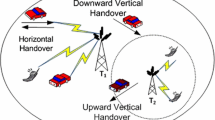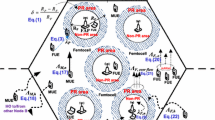Abstract
The paper presents a performance evaluation and resource management of hierarchical MACRO-/MICRO cellular networks using the new Modeling and Evaluation Language (MOSEL-2). MOSEL-2 with new constructs has the ability to find the performance and reliability modeling and evaluation of systems with exponential and non-exponential distributions. A MACRO/MICRO cell structure is solved numerically and mathematically in this paper to handle the handoff calls. Additionally, a simulation program is written to validate these results. In order to reduce the loss probability, a guard channels are introduced at the MICRO cell and channel reservation at the MACRO cell. Additionally, the concept of queuing is introduced where there is a possibility for the handoff calls from both MACRO and MICRO layers to be queued when all the resources are occupied. MOSEL-2 is used to find the numerical solution for this problem with both exponential and general exponential (GE) distribution. The performance analysis show the efficiency of the proposed scheme to manage the handoff calls and the ability of the suggested scheme to reduce the blocking probability of handover calls and the loss probability as the main objective is to block the new connection rather than terminating the ongoing connection as well as balancing the load all over the whole network. It is shown in this paper that there are a set of important factors that affect the performance, such as: reservation policy, channel allocation, handover ratio, capacity of the queue and the variation of the inter-arrival times. These factors are discussed via some important performance measures, such as: new call blocking probability, blocking probability of handover calls, loss probability, utilization and the average delay of the queue.
Similar content being viewed by others
References
Liu, X., & Fapojuwo, A. O. (2005). Resource management for handoff traffic in hierarchical cellular networks. IEEE International performance, Computing and communications conference (IPCCC2005); 615–620.
Lagrange X. (1997) Multi-tier cell design. IEEE Communications Magazine 35(8): 60–64
Lagrance, X., & Godlewski, P. (1996). Performnace of hierarchical cellular network with mobility dependent handover strategies. In Proceedings of IEEE Vehicular Technology Conference, issue 3, pp. 1868–1872.
I vanov, K., & Spring, G. (1995). Mobile speed sensitive handover in a mixed cell environment. In Vehicular Technology Conference, VTC’95, pp. 892–896, July, 1995.
Benveniste, M. (1995). Cell selection in two tier microcellular/macrocellular systems. In GLOBECOM’95, November, 1995.
Pollini, G. P. (1996). Trends in handover design. In IEEE Communication Magazine, pp. 82–90, March, 1996.
Oh S.-H., Tcha D.-W. (1992) Prioritized channel assignment in a cellular radio network. IEEE Transactions in Communications. 40: 1259–1269
Cox D., Reudink D. (1972) A comparison of some channel assignment strategies in large mobile communication systems. IEEE Transactions in Communications 20: 190–195
Acampora, A. S., & Naghshineh, M. (1994). Control and quality of service provisioning in high speed micro cellular networks. IEEE Personal Communications, 1.
Hong D., Rappaport S. (1986) Traffic modelling and performance analysis for cellular mobile radio telephone systems with prioritized and non-prioritized handoff procedures. IEEE Transactions on Vehicular Technology 35: 77–92
Guerin R. (1988) Queueing blocking system with two arrival streams and quard channels. IEEE Transactions in Communications 36: 153–163
Yu O.T.W., Leung V.C.M. (1997) Adaptive resource allocation for prioritized call admission over an ATM-based wireless pcn. IEEE Journal on selected areas in Communications 15(7): 1208–1225
Rappaport S.S., Hu L. (1994) Microcellular communication systems with hierarchical macrocell overlays:Traffic performance modells and analysis. Proceedings of the IEEE 82(9): 1383–1397
Beraldi Marano, S., & Mastroianni, C. (1996). A reversible hierarchical scheme for micricellular systems with Overlaying Macrocells. Proceedings of INFOCOM’96, SanFrancisco, USA, pp. 51–58.
Begain, K., Bolch, G., & Herold, H. (2001). Practical performance modelling, application of MOSEL language, Kluwer Academic Publisher.
http://www4.informatik.uni-erlangen.de/Projects/MOSEL/(Date-of-Access 2006).
Hirel, C., Tuffin, B., & Trivedi, K. S. (2000). SPNP:Stochastic Petri Nets. Version 6.0, In Proceedings of the 11th International Conference on Computer Performance Evaluation: Modelling Techniques and Tools, London, UK: Springer-Verlag, pp. 354–357.
Zimmermann, A., Freiheit, J., German, R., & Hommel, G. (2000). Petri net modelling and performability evaluation with TimeNET 3.0, In Proceedings 11th International Conference on Modeling Techniques and Tools for Computer Performance Evaluation (TOOLS’2000), Vol. 1786 of LNCS, pp. 188–202, Springer.
Wuechner, P. (2003). Performnace modelling of mobile networks using MOSEL-2, M.S.Thesis, Department of computer science, Germany, University of Erlangen.
Buetel, B. (2003). Integration of the petri net analysator TimeNET into the model analysis environment MOSEL, Nürnberg: University of Erlangen. http://www.linguistik.uni-erlangen.de/~bjoern/mosel2.pdf.
Wüchner, P. (2003). Extending the Interface between the modelling language MOSEL and CSPL by adding simulation constructs, Nürnberg: University of Erlangen. http://www.xnwchner-3ya.de/pub/MOSEL2-2_PW.pdf.
Wüchner, P., De Meer, H., Barner, J., & Bolch, G. (2006). A brief Introduction to MOSEL-2, in Proceedings of 13th GI/ITG Conference: Measuring Modeling and Evaluation of Compuetr and Communication Systems, pp. 473–476, Nürnberg, Germany.
Greiner, S., Bolch, G. (1995). Modeling production lines with blocking, batch processing and unrealistic machines using the Markov analyzer MOSES. In Proceedings European Simulation Symposium, ESS’95, pp. 303–309.
Khalid Begain: (1993). Using subclasses of ph distributions for the modeling of empirical distributions, In Proceedings 18th ICSCS, pp. 141–152.
Cooper R.B. (1981) Introduction to queueing theory. North Holland, New York, USA
Author information
Authors and Affiliations
Corresponding author
Rights and permissions
About this article
Cite this article
Zreikat, A.I., Yerima, S. & Al-Begain, K. Performance Evaluation and Resource Management of Hierarchical MACRO-/MICRO Cellular Networks using MOSEL-2. Wireless Pers Commun 44, 153–179 (2008). https://doi.org/10.1007/s11277-007-9350-8
Received:
Accepted:
Published:
Issue Date:
DOI: https://doi.org/10.1007/s11277-007-9350-8




